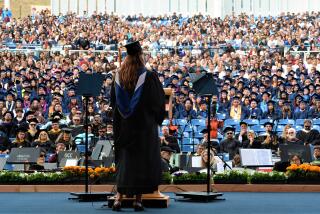When colleges cheat
Society trusts teachers and school administrators to deliver a lesson arguably more important than reading and math: Cheating is not only forbidden but dishonorable. How discouraging and frustrating it is, then, to discover yet another instance in which an institution itself has been caught violating the rules. On Monday, Claremont McKenna College announced that an official there inflated the SAT scores of incoming students to make the school look good in national rankings, including the overhyped lists published annually in U.S. News & World Report.
This follows revelations last year of widespread cheating on state standardized tests by public school teachers and administrators in Georgia, New York and Pennsylvania. To a lesser extent, some schools in the Los Angeles region have been involved. As a sign of how worrisome the problem has become, the U.S. Department of Educationis soliciting public opinion until Feb. 16 on how to stop cheating by schools.
It is bad enough when teachers cheat on tests, but when the cheating is carried out at a college — supposedly an unimpeachable bastion of the disinterested pursuit of pure truth — the notion of honor seems fragile and fleeting indeed.
The truth is, this sort of trickery has been going on at colleges for many years, as they sought to burnish their images. Maybe they didn’t out-and-out change numbers, but they certainly manipulated them. According to a 1995 report by the Wall Street Journal, this included omitting the SAT scores of (take your pick) bottom scorers, international students, disadvantaged applicants and athletes before the scores were reported to various publications.
A more recent gambit is SAT-optional admissions. A growing number of colleges leave it up to applicants whether to divulge their SAT scores. To some degree, that reflects a lack of confidence in the college admissions test, but it also happens to boost the colleges’ rankings in U.S. News and other publications because only the highest scorers submit their results. Statistical shenanigans involving recruitment and acceptance are even worse, because they hurt students. For example, some schools encourage applications from students they know have no chance of being admitted because a high application-to-acceptance ratio is a ranking boost.
Colleges and public schools are under pressure to look good, which means they must also ramp up efforts to ensure that’s done ethically. Do teachers cut students a break if they’re caught cheating on final exams because of academic pressure? No, those students receive a big, fat zero. As schools continue to lecture on the importance of trustworthy behavior, more of them need to look inward and honestly assess whether they behave with the same honor they demand of their students.
More to Read
A cure for the common opinion
Get thought-provoking perspectives with our weekly newsletter.
You may occasionally receive promotional content from the Los Angeles Times.










